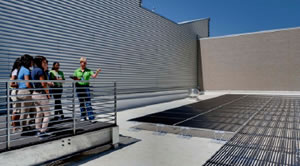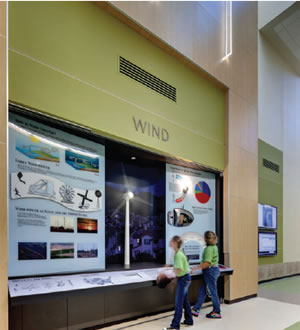Beyond Net Zero
- By Sangeetha V. Karthik
- 11/01/13

PHOTOS COURTESY OF CORGAN ASSOCIATES
Soon after Lady Bird Johnson Middle School opened in Irving, Texas, students began to notice on a visible energy monitor that the restrooms were showing red, indicating an over-use of power. When they heard that electric hand dryers caused a power spike, they started discussing the differences between hand dryers and paper towels regarding energy conservation and reduction of landfills.
Ideas can be taught through a lecture, but a school building teaching the same concept through simple, everyday activity can be lasting and empowering. Physical environments can have a profound influence on their users. The buildings can inspire, nurture, comfort, heal and teach. In recent years, educational facilities have evolved from “passive places” to “engaging spaces” that evoke, demonstrate and challenge students and teachers.
Designed to be the first net-zero energy public school in Texas and LEED Gold-certified building, Irving Independent School District’s Lady Bird Johnson Middle School is a trendsetter in several areas of school design and construction. The 150,000-square-foot facility produces as much energy as it uses and serves as a model for net-zero facilities. The building is a living learning laboratory, not only for the students that attend this school, but for the entire district. Students from different grade levels experience and learn from the sustainable features incorporated into the facility.
“The designed environment for Lady Bird Johnson Middle School provides an integrated approach of educational opportunities for our students. There is nothing more valuable than real-life applications relative to the learning process,” says Scott Layne, assistant superintendent of the district, who spearheaded the project.
The data collected from this building helps students, teachers and community members understand the benefits of the sustainable systems in public buildings, schools in particular. Two years of data proves that besides meeting the net-zero goal, the school uses less paper compared to the other schools within the district.
According to Kelly Horn, director of Facilities for the district, “Adding a facility that virtually teaches on its own and draws you in with its interactive displays of technology has been a great experience for our students. In the beginning, net zero was our goal, relative to energy consumption for operation purposes and, in the end, net zero is our reality. The cost of creating this reality was well worth it for our community.”
 Lady Bird Johnson Middle School, the eighth middle school in the Irving Independent School District, was built to alleviate crowding at the existing middle schools and cap student enrollment at each campus. This facility successfully integrates IISD’s initiative of being pioneers in the field of teaching/learning and stewards of the environment. The design team from architecture firm Corgan, integrated active and passive energysaving technologies in the building for better lifecycle costs and lower maintenance cost. The building strategies to achieve the netzero designation include increased wall and roof insulation, geothermal HVAC system, reduction in storm-water runoff through permeable paving, high-efficiency glazing, solar shading, rainwater collection, graywater harvesting, holistic energy monitoring, daylight harvesting, ENERGY STAR-rated kitchen, pulper in the kitchen, water well for irrigation, holistic monitoring of energy use.
Lady Bird Johnson Middle School, the eighth middle school in the Irving Independent School District, was built to alleviate crowding at the existing middle schools and cap student enrollment at each campus. This facility successfully integrates IISD’s initiative of being pioneers in the field of teaching/learning and stewards of the environment. The design team from architecture firm Corgan, integrated active and passive energysaving technologies in the building for better lifecycle costs and lower maintenance cost. The building strategies to achieve the netzero designation include increased wall and roof insulation, geothermal HVAC system, reduction in storm-water runoff through permeable paving, high-efficiency glazing, solar shading, rainwater collection, graywater harvesting, holistic energy monitoring, daylight harvesting, ENERGY STAR-rated kitchen, pulper in the kitchen, water well for irrigation, holistic monitoring of energy use.
Building becomes part of the curriculum
“Learning by doing” is a theme throughout the building. “Hopefully, the innovations present at Lady Bird allow students to not only learn, but to learn in an educational setting conducive of 21st-century learning,” says Layne. “The days of classroom lecturing by one individual are antiquated and no longer stimulate students’ minds. Lady Bird allows for this paradigm shift, creating a ‘science room setting’ throughout the building.”
Administrators and teachers note the positive attitude and a sense of ownership amongst the students. Engaged users make a good school building even better. Inquisitive students make this facility vibrant.
The district’s science department was actively involved during the planning process of the building and rewrote its curriculum to include the sustainable features in lesson plans. The holistic monitoring system in the facility provides on-site and web-based real-time information of each system and the building as a whole. The monitoring software tracks over-use of allocated power in rooms with red, which is prominently displayed on several monitors in the main corridor. Competition among classrooms, based on energy data collected, teaches students valuable lessons on conservation of resources.
The wireless environment promotes learning and working outside classrooms. Interactive displays in the main corridor provide hands-on learning opportunities for geothermal, solar, wind and water conservation technologies and systems. Older students can be seen explaining the ideas of sustainable design and renewable resources to their peers and younger students.

Living Learning Laboratory. Lady Bird Johnson Middle School opened in Irving, Texas, produces as much energy as it uses. The data collected from its systems are displayed on monitors in the main lobby to help students, teachers and community members understand the benefits of sustainable systems. While the wind turbines on-site generate only minimal power, they play an integral role in understanding the lesson plans integrated into the curriculum.
To accommodate students throughout the district visiting this facility, the Omni room, a large learning science flexible lab, is located near the front entry and adjacent to the library area. Students can gather in the Omni room and learn prior to proceeding into the building. In another area, an exposed water source heat pump with red and blue lines to indicate temperature of the water in and out of the unit serves as a visual aid for students to grasp the concept of geothermal systems. An interactive light-tracing exhibit in the Earth node, along with an exposed purge port, is also used as teaching tools.
On the solar observation deck, students can see the solar array installation. The solar inverters are housed in an interior room with large windows to let students see the power generation numbers in real time. A large sundial, with seating, serves as a gathering place, while familiarizing the students with the concepts of sun path, seasons and interactions with the building’s sustainable systems.
The wind turbines on-site generate only minimal power, but play an integral role in understanding the lesson plans integrated into the curriculum. The wildflower garden in front of the school demonstrates the relevance of native planting. A pulper is used to reduce the cafeteria waste and prominent recycle areas throughout the building inculcate the habit of recycling.
Shortly after it opened in 2011, students were given an assignment on the LEED certification process. The exercise led to constant emails from the students to the principal and the design/construction team on the status of their building certification. The students were not satisfied until their school received the LEED Gold plaque. Students in Lady Bird Johnson Middle School are taught the systems and their benefits to the economy and environment. Projects in varied subjects utilize the system data to further engage students in their learning environment. They are given the opportunity, information and support to become stewards of the environment and understand how their actions can affect their community and future.
Designed for a new way of learning
This building is designed to meet the demands of 21st-century learning. Hands-on learning improves critical thinking and problemsolving skills needed in the work place environment. Spaces, furnishings and equipment were selected to promote a project-based learning environment. Flexible furniture in classrooms allows easy reconfiguration for individual and group activities. The media center’s layout can be changed based on the school’s needs, by the use of moveable shelving. Windows between the classrooms and interior corridors reduce the need for artificial lighting and allow monitoring of students.
A school can be so much more than a building, and Lady Bird Johnson Middle School is proving it every day. According to Angie Gaylord, director of Professional Development, “This school has opened so many new doors for students, faculty and staff.” Gaylord was the first principal at this facility and worked closely with the design and construction team from the inception of the project. She is quick to admit changing old ways was not an easy process, but that the results have proven to be enriching and empowering for students, faculty and staff. Efficient systems and effective technology will not matter if used incorrectly and improperly. Irving ISD’s vision is made a reality by the people who use the building every day.
When you walk through the school, you see 6th grade students engrossed in their electronic readers in the media center, 8th graders collaborating with their peers on the built-in benches under the stairs, teachers working with students in their classrooms. It’s just another day of school in Irving ISD’s net-zero facility. Long after the building has graced multiple magazine pages and stacked up awards, USGBC Green School of the year winner, IISD Lady Bird Johnson Middle School continues to nurture, teach and promote sustainability for future generations.
This article originally appeared in the School Planning & Management November 2013 issue of Spaces4Learning.